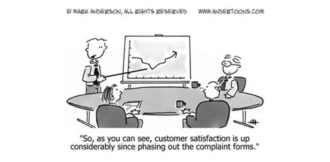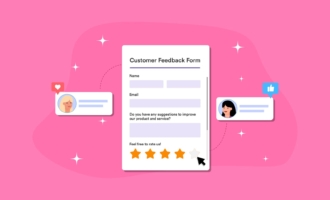People have an average of 70,000 thoughts a day. Some of these thoughts will naturally be about the businesses, products, and services they use. For business owners, finding out what their customers are thinking is vital to improving performance and boosting sales. That’s where customer feedback processes can help, including surveys, polls, and conversations.
Customer feedback is most forthcoming and accurate immediately following an interaction with a business. At the end of a call with a service representative, within a few minutes following an online purchase, or after a chat with tech support — these are the moments when asking for feedback will result in a fresh, honest response.
It’s called real-time feedback, and every company should use it. Why? Let’s take a look at the five benefits of real-time feedback.
1. It strengthens customer trust
When you ask customers for feedback, they feel valued and appreciated. It shows the company cares about their opinion. And when you request feedback in real-time, it’s even more powerful as it becomes an inseparable part of the customer’s immediate experience. This is true even in cases of negative feedback.
In fact, 45 percent of unhappy customers are willing to withdraw their negative feedback after an apology, while only 23 percent would do it in return for monetary compensation. The bottom line is that all people want to be treated with respect. Turning to customers for feedback at the moment is a great way to show them the respect that leads to trust and goodwill.
2. It’s fresh and accurate
Memory bias is real. The passage of time tends to alter the content of memory, highlighting certain aspects out of proportion or burying other aspects as unimportant. This makes for great storylines on Law & Order, but for business owners, it makes getting accurate customer feedback a challenge.
Real-time feedback is the antidote, as there’s no time for the customer’s memory of the experience to become tainted. The feedback questions are presented as soon as the interaction is over, whether at the end of a live chat, support call, or purchase. The fresher the feedback, the more reliable and accurate it is.
What’s more, Pew research shows that 4 to 7 percent of online survey responses are bogus. Getting real-time feedback from actual, verified customers is a good way to dilute the fake responses and get a more realistic overall picture of customer sentiment.
3. It gets higher response rates
Customer feedback surveys typically get response rates of between 5 and 30 percent. Feedback requested immediately after an interaction, however, can get up to an 83 percent response rate!
When a customer has just completed an interaction, their attention is still on your product or service. One day, a week, or a month later, their minds are elsewhere, and you’ll miss the opportunity to grab hold of that enthusiasm and willingness to share.
Real-time customer feedback is there for the taking; companies that make the effort to get it will find a rich harvest of valuable information to boost their business performance.
4. It helps pinpoint issues down to the exact day and time
Every business has ups and downs. A bug on the website causes errors during the checkout process, which means lost sales. An overload of service calls leads to longer call wait times, more hangups, and unhappy customers.
A benefit of real-time feedback is that the day and time it’s received precisely match the customer’s experience. This can make it much easier to identify and solve problems.
Sometimes, real-time customer feedback notifies the company about an immediate and pressing problem they were unaware of, like a glitch in the website. In other instances, the feedback confirms an issue that was already suspected.
Knowing how customers feel provides solid evidence that a problem does indeed exist and must be dealt with. Either way, having real-time feedback with a precise timestamp provides an ongoing and up-to-date flow of information about company operations and customer experiences.
5. It enables quick improvements
Is there anything more annoying to customers than when a business drags its feet in solving a problem? Whether it’s a delivery error, a technical issue that requires a service call, or a request for a refund, it’s vital to make customers feel that their complaint is being attended to and that they are more than just a number.
Problems happen; every customer knows this. It’s not the problem per se that causes a customer to abandon a brand. It’s when the company takes too long to resolve it. In fact, according to Harvard Business Review, when a complaint is fixed within 5 minutes, the customer will spend even more money with the company in the future.
There’s only one way a company can solve customer complaints that fast, and it’s with the help of real-time feedback. But how do you gather this feedback and respond to it efficiently?
Jotform not only provides feedback forms you can use to collect feedback, but this information can automatically populate the connected table in Jotform. From this workspace, you can immediately assign complaints to the relevant employee or team so that they can be handled quickly.
Getting feedback in real-time and integrating it with company operations enables businesses to manage issues quickly and smoothly — this is a huge boost to performance and profitability.
Real feedback in real time
In a world where consumers have so much choice, and competition is high, getting customer feedback isn’t just good business practice — it’s an essential part of running a healthy and productive business.
Companies that take their feedback process up a notch, putting systems in place to gather real-time customer feedback, can reap even greater benefits. Feedback collected in the heat of the moment is the best kind, providing fresh, accurate insights that fuel real change and improved performance.











































































Send Comment: